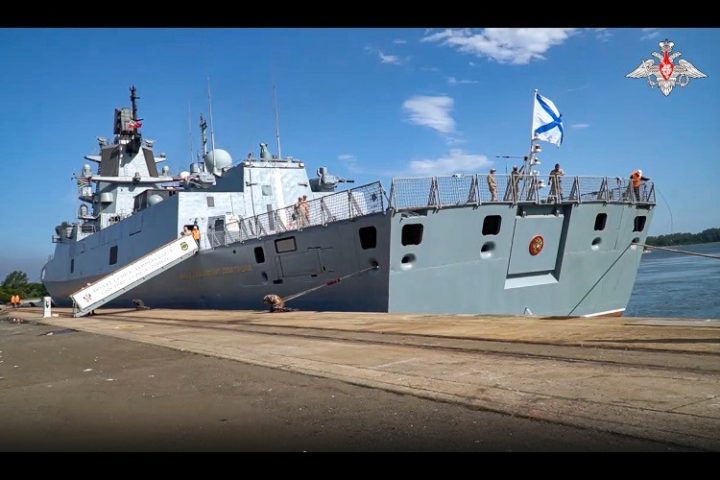
The Russia-China alliance is rapidly accelerating its military and economic capacities at a rate poised to soon leave the United States cornered.
The global powers of Moscow and Beijing are conducting joint military exercises this week with South Africa off the latter’s coast. The war games began Wednesday and are programmed to run for five days.
A U.S. official speaking to CBS News said the American government is “concerned” about the joint exercises, particularly because they come as Russia continues its war in Ukraine.
Earlier this month, Russian media reported that participating in the war games would be the Russian frigate Admiral Gorshkov, which would perform a training launch of a Tsirkon missile aimed at a “surface target” more than 300 miles away. The outlet, the TASS news agency, quoted “a source close to Russia’s defense industry,” although the Russian government at the time did not confirm use of the missile.
During a Wednesday news conference held aboard the South African frigate SAS Mendi, the Russian commander said the Admiral Gorshkov is equipped with hypersonic missiles but would not be firing them.
CBS news noted of technology and this week’s exercises:
Russia has been at the vanguard of efforts by many nations, including the U.S., to develop hypersonic glide missiles, which can be harder to detect and intercept due to their speed and maneuverability. Russia and China have outpaced U.S. efforts on the weapons systems thus far. Moscow claimed in March 2022 to have used a hypersonic missile in Ukraine in what would have been the first use of the weapon on any battlefield, though U.S. officials never confirmed one was actually used. Two months later, the Russian Defense Ministry was quoted by TASS as saying it had conducted a successful test of a Tsirkon, hitting a target about 620 miles away.
… The exercise, dubbed “Mosi II,” which means smoke in the Tswana language, has drawn widespread criticism that South Africa has abandoned its claimed neutrality in the Ukraine war. The exercise will see simulated combat attacks on the ships and involve air defenses using South African and Chinese helicopters and Chinese and Russian high-speed boats. They will also practice maneuvers to rescue ships from piracy and to remove sea mines.
Putin notably called the Tsirkon part of a new class of “invincible” Russian weaponry.
The Admiral Gorshkov, docked along the South African coast for journalists to see on Wednesday, had painted on it the white letters “Z” and “V”, which have become pro-war Russian military symbols — the “Z” serving, according to the Russian Ministry of Defense, as an abbreviation of “for victory” in Russian, and the “V” representing the phrase “strength is in truth.”
South African Chief of Joint Operations Lieutenant General Siphiwe Lucky Sangweni told the press that these exercises were conceived two years ago, countering accusations that they were scheduled amid the war in Ukraine.
South Africa is one of the 35 countries that abstained from a vote in the United Nations to condemn Russia for the war.
Naledi Pandor, South Africa’s Minister of International Relations and Cooperation, pushed back at those criticizing her country for hosting the war games with Russia and China. She said during a January news conference that attempting to prevent South Africa from conducting joint military exercises from countries it chooses to is an “an abuse of international practice.”
Also this week, Russian President Vladimir Putin said that trade between Russia and China is set to hit its $200 billion goal for 2024 earlier than anticipated.
“We set a goal of reaching the level [of trade turnover] of $200 billion in 2024. Last year, it was already $185 billion, there is every reason to believe that we will reach our goals in terms of trade turnover, maybe even earlier than we planned,” Putin said on Wednesday while speaking at a meeting with China’s top diplomat, as quoted by Russia’s RT.
As the outlet notes, trade turnover between Russia and China grew by almost a third last year. Data from China’’s Customs Administration reveals that the country exported $76.1 billion worth to Russia in 2022 — a hike of 12.8 percent over 2021. Meanwhile, Russian exports to China grew by 43.4 percent, equivalent to $114.1 billion.
Additionally, both Russia and China are cementing their relationships with Iran. As The New American has previously reported, Moscow has now become the number-one foreign investor in Iran, according to the latter’s deputy finance minister, Ali Fekri.
And Beijing and Tehran are finalizing several bilateral cooperation agreements aimed at integrating the two nations’ economies to a historically unprecedented degree.
Thus far, Iran and China have signed at least 20 agreements and documents, which outline economic cooperation in the areas of intellectual property, information technology, health, and international trade.
What’s clear is that the once seemingly invincible global world order presided over by Washington and Brussels is on the verge of sinking into irrelevance as China and Russia create their own alternative, parallel world order — one to which more countries are increasingly being drawn.




